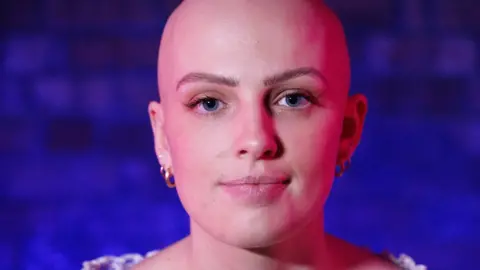2 hours ago
By Gemma Dunstan, BBC Wales Live
 BBC
BBCWhen Poppie Davies’s hairdresser noticed a bald patch when she was just 16, it ended with her unable to look in the mirror as she lost her hair to alopecia.
The 21-year-old from Cardiff said it “snowballed” and became “life-altering” which led her to also losing her confidence.
Celebrities including Jada Pinkett Smith and Louis Theroux have been praised for sharing their experiences with alopecia – a disease that occurs when the immune system attacks hair follicles and causes hair loss.
The first NHS treatment for it was announced earlier this year, but not all health boards in Wales are prescribing it yet.
Poppie said she believed she had to keep her alopecia a secret, adding: “I felt I had to cover it up when I was in school.
“In my head no-one could know, wearing a wig was a chore. It was quite isolating.
“I would even wear a wig into the garden in case my neighbours saw me.”
She decided going to university was a good point in her life to take a different approach, and said her new friends have been incredibly supportive.
“It was a long five years, but I’ve learnt to own it. If I don’t want to wear a wig then I won’t, if I want to wear a wig and style it – that’s also fun,” she added.
Poppie said there is an “incredible community” both online and in person, and she contacted a local support group, which helped her regain her confidence.
“Now I look at the positives and how I can help other people,” she said.

Ben Lowrey, 40, took a different approach by channelling his energy into fitness, and became a naked model.
In 2012, the exercise fanatic who lives in Rhondda Cynon Taf lost all of his hair within a few months.
“I couldn’t control my hair, but fitness was something I could,” he said.
“I didn’t have much negativity, more positive attention for being in shape.”
He joined an agency, becoming a “butler in the buff” and posed as a life drawing model for hen parties and events.
“I became much more confident, it wasn’t just being naked – it was taking charge of a room and speaking to groups of people and being part of their special event,” Ben said.
He said given the option, he would not choose to have his hair back.
“Alopecia forced me to be confident in other ways, to focus on my values, goals and principles,” he added.
 Ryan Rush
Ryan Rush Ryan Rush’s story starts when he was much younger.
He had his first bald patch develop in his hair when he was four years old.
The 22-year-old, who lives in Caerphilly, said it developed further until he was 10.
“I took my eyebrows for granted, losing them affected me more than my head hair as it’s more noticeable and harder to disguise,” Ryan said.
He said in secondary school, as his condition developed, he had some negative comments aimed towards him.
Ryan added: “It was verbal bullying mainly, but generally it wasn’t too bad. I think the attention was more out of curiosity.”
He had not met anyone with the condition until he was on holiday as a teenager, and believes representation is important.
Last year he also saw model Adam Rhazali, who has the condition, on a billboard in Cardiff.
“It was amazing, just to see someone like me putting themselves out there,” he said.
“It made me feel proud, confident and more comfortable.”
What is alopecia?
- Alopecia is the general medical term for hair loss
- Hair loss can be hereditary or caused by things such as stress
- It is typically an autoimmune condition where the immune system attacks the hair follicles
- It can affect hair across the body
- Some types of alopecia are temporary while others can be permanent
More information can be found on the NHS website

In February, a medicine called Ritlecitinib or Litfulo was approved for the NHS to prescribe to some patients.
Dr Manju Kalavala, a consultant and clinical director for dermatology at the University Hospital of Wales in Cardiff, called it “good news”.
He has seen a “huge spike” in demand from those with hair loss, but there was a waiting time of up to two years post-pandemic.
“We worked hard and managed to bring it down,” he said.
“Right now, we’re running around 42 weeks of waiting time. At the same time, we recognise that we can’t keep patients waiting for that long.”
Dr Kalavala said schemes trialled by the Cardiff and Vale health board have now been taken up across Wales to help patients receive help as early as possible.
“We’re carrying out teledermatology so GPs can send a referral with a photograph attached,” he said.
“We reply in a few days and can ask for tests and offer advice so it helps speed up the process whilst they’re waiting to see us.”
